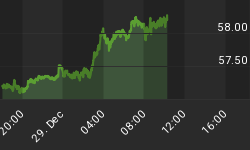Worldwide investment in agriculture stocks shows no sign of abating. The reason is simple: food prices are rising, and are likely to continue doing so. And yet the Food and Agriculture Organization of the United Nations (FAO) reports that food prices are stable and nowhere near the elevated prices of 2011. And the World Bank is even predicting a modest reduction in food prices. So what should investors think?
Let's take a close look at the facts. The price of beef has just experienced its greatest surge since the end of 2003. According to the Wall Street Journal, food is expected to rise by 3.5% in 2014 based on current trends. This global surge in food prices is already resulting in riots in Venezuela. And just as it was in the past during years of high food prices, such as in 2008 and 2011, more social unrest should be expected, globally.
Back in 2009 my readers were told about Market Vectors Agribusiness ETF (MOO). It's now up over 100%. Yet I'm still bullish, not just on MOO, but agriculture stocks in general. There are eight reasons:
- Demand for food is increasing consistently along with GDP per capita across the globe, particularly in countries like China and India.
- Global growth in the so-called middle class, substantially increasing demand for meat.
- Agricultural productivity growth rates are on the decline.
- Globally, Class 1 farmland availability is in a deficit.
- Other non-food crops such as for biofuel are competing with corn, soy, and wheat.
- Government interference continues to disrupt supply and demand.
- Droughts, dwindling water sources, and increased water usage across the world is resulting in water scarcity and affecting agricultural irrigation availability.
- The global
 cooling phase has now kicked-in, inevitably affecting crop production.
cooling phase has now kicked-in, inevitably affecting crop production.
Another significant factor is the massive grab for agricultural land throughout Africa and South America. Sovereign wealth funds, state-owned corporations and institutional investors are behind this. Not only is this driving arable land prices higher, but it is further evidence that long-term investors see the writing on the wall: they are prepping for a sustained surge in food prices.
It's not like arable land can be easily manufactured. Efforts to transform Brazil's forests into farmland are short-term fixes. Their soil tends to be shallow and acidic, lacking the fertility for long-term productivity. Good fertile land is hard to come by.
China is particularly troubled by this. Only 10% of their geography consists of arable land. To complicate matters further, they represent 20% of the global population. Yet they only have 7% of the earth's freshwater. They don't have enough fresh water to irrigate what precious-little farmland they've got. They're diverting rivers to try to compensate, but it's a band-aid. The problem is likely permanent. And their demand for food, and particularly meat, is surging.
We also see demand for meat skyrocketing in other developing countries --- from Brazil to "vegetarian" India. This is due to rising incomes. Estimates are for global meat demand to increase by 100% within the next 30 years. Meat production is very land and water intensive, both from a grazing perspective and also due to hay/grain inputs. This bodes well for people who own farmland, water rights, agriculture stocks, and water sector investments.
All this is in addition to the ever-present threats of crop failures, geopolitical disruptions, and oil shocks. The price of oil is highly correlated with the food price index. If you are bullish on oil, you should be bullish on agriculture.
Will there be a worldwide food crisis? The probability is high. The timing is unknown, but even without a full-blown crisis, there will be sustained pressure on the global food supply. And that's good news for agriculture investors, who can ride this trend by investing in simple ETF's such as MOO to farmland funds to commodities to agricultural securities. I provide details in my Sterling Intelligence email letter, which is free.
















